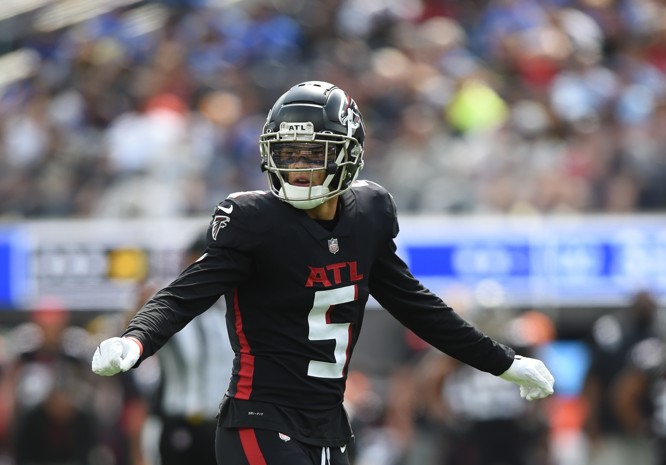One has to wonder what Drake London would look like in a different offense. In two weeks against solid defenses, London has gone 13/19 for 160 yards, one touchdown, and a two-point conversion. As the top receiver drafted in the 2022 NFL Draft (and probably your rookie drafts too), he seems to be earning the capital spent. It certainly appears that he has made his place, but has he completely dispelled any translation concerns?
The concerns he would have to overcome include the following:
- Route running
- Separation
- Speed
- Release vs. Press
The Tape
The statistics are almost enough evidence of the translation of his skillset, but does the tape confirm anything for us? Let’s start with the one thing we knew about him coming into the league: his physicality and the contested catch ability. These next two plays aren’t contested catches by the strictest definition, but they do show us something.
Competitive Toughness and Route Running
Aside from the video captions, we see some route-running nuance, sharpness in his cut, and competitive toughness. Starting with the route running nuance, notice how he stems inside but then pushes vertical for a step just before his break. This is textbook because it keeps the off-coverage DB backpedaling to maintain his cushion. It is now virtually impossible for the DB to undercut this play if the ball is on time.
London explodes out of his cut to the spot, but there are two underneath defenders closing in on him. London does not shrink despite incoming contact and even leaves his feet slightly to catch this ball. He then tucks the ball away quickly to his body and sustains the hit.
Part of route running is timing in the context of adjacent routes or the play itself. London shows some intelligence here in his ever-so-slight delay getting off the ball. This allows Kyle Pitts’ route on this “Knife” concept to pick off Robert Rochell (#31). The play design creates just enough space for Marcus Mariota to squeeze in the ball. None of this works if he is hurried or late getting off the snap. Also, we get another sample of his competitive toughness with incoming contact. As you can see, his concentration was as if Nick Scott (#33) was not there.
Finding the Soft Spot
Route running skill includes getting open versus man and settling into Zone soft spots. Drake London has put on tape that he can do this well.
We will probably see a lot of this in the coming weeks, where Pitts is a part of the dynamics that create space for London. While this may seem like a dependency for success, we must recognize what London is contributing. On this Levels “Crease” concept, the clip doesn’t identify that London widened that eventual box created by the defenders at the catch point. He accomplished this by attacking the corner’s outside leverage with his stem. In Cover 2, the corner has help in the safety, and the DB’s priority is to not get beat outside by using the sideline as an extra defender. London would probably still win if this coverage was tighter, but why not make your job easy?
This play is somewhat similar to the last, but for the spacing between him and Pitts. He doesn’t attempt to widen the outside DB this time since Cover 4 gives the DB some help. Instead, he uses an aggressive stem and breakpoint, virtually “stepping on his toes”. This accomplished two things: forces the DB to open his hips upfield and allows London to create space as he flattens his Dig route. The play design takes care of any help, but the route-running nuance ultimately makes this work.
Outstanding Questions
I still want to see a little more evidence of his success versus press coverage. Specifically, we need to see his success against attempts to jam him. As the season presses on, we should get more opportunities to see this. In Week 1, he saw a lot of press looks versus Marshon Lattimore, but only one such look in Week 2 versus Jalen Ramsey. Only 22% of routes run on pass plays being against press coverage, and of those, he only saw targets on 23% (3 of 13). To London’s credit, he did flash some success against Lattimore, but the performance in these situations did not display an edge in favor of London. Without some level of consistent success against very good/elite DBs, the upside we all imagined will be capped.
There are some encouraging signs about what we are seeing so far in his usage. London is showing a diverse route tree through his first few weeks, only running a “Go” on less than 9% of his routes. So many times, I see rookie wide receivers relegated to “Nine” routes while knowing they could do so much more. In contrast, rookie “Go” routes have been run at the following rates:
- Treylon Burks – ~22%
- Jahan Dotson – ~21%
- Christian Watson – ~16%
- Garrett Wilson – ~9%
- Chris Olave – ~22%
While I do not have any data to back up a correlation between career success and early route tree diversity, I wouldn’t be surprised if it was a predictor of long-term success. If nothing else, it should be an indicator of route running ability and the Falcons’ trust in his ability to separate. We should continue watching him for more evidence he can succeed outside of a schematic pairing with Pitts. Man, I wish they had a more accomplished passer. Then we might see his true ceiling.
Keep following me @FFB_Vern for more Tracking Translation and the ultimate verdict on Drake London’s translation into the NFL. He’s close, but we just need to see a little more. Make sure you are part of the NerdHerd so that you can use tools like DynastyGM, the film room, and NerdScore to stay ahead of your competition!
